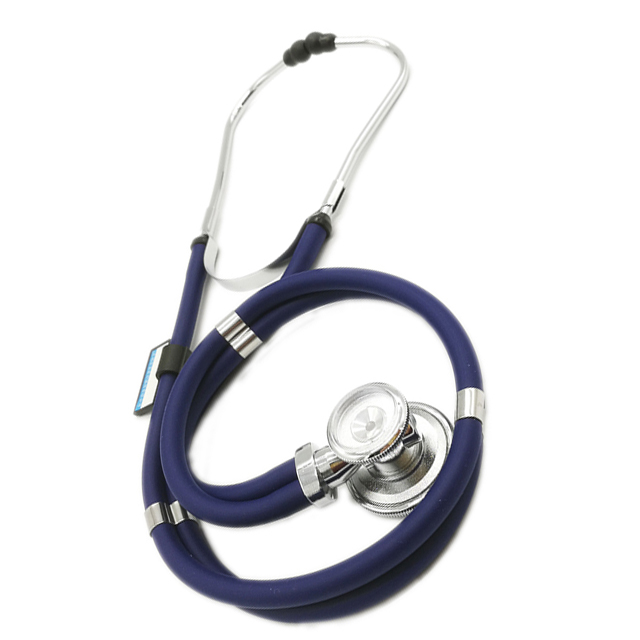Understanding the Anatomy and Design of a Clinical Stethoscope
A clinical stethoscope is an essential tool in the medical field, serving as an extension of the healthcare provider's senses. Understanding its anatomy is crucial for its proper use. Typically, a stethoscope consists of several key components: the chest piece, tubing, and earpieces. The chest piece can have a diaphragm on one side and a bell on the other; the diaphragm is used for higher frequency sounds, such as breath sounds, while the bell is useful for detecting lower frequency sounds like certain heart murmurs. The tubing transmits sound from the chest piece to the earpieces, which should fit snugly and comfortably in the examiner's ears to ensure optimal sound transmission. Familiarizing oneself with the different types of stethoscopes, including basic models and advanced options like electronic and digital stethoscopes, is beneficial. Each type has its place in clinical medicine, from general examinations to specialty uses such as pediatrics or cardiology. Custom Clinical Stethoscopes, ODM Clinical Stethoscopes, and OEM Clinical Stethoscopes are also available to cater to specific needs, with manufacturers offering tailored features to enhance diagnostic capabilities.
Preparing the Stethoscope for Use
Proper preparation of a clinical stethoscope is integral to achieving accurate results. Before placing the stethoscope on a patient, ensure that it is clean and in good working condition. Regular cleaning is essential to prevent cross-contamination between patients and to ensure the instrument's longevity. Adjust the earpieces to fit comfortably in your ears; they should be angled forward to align with the natural curvature of the ear canal. Checking the stethoscope's functionality is also vital—make sure that the chest piece is connected securely to the tubing and that there are no cracks or damage that could interfere with sound transmission. When dealing with wholesale clinical stethoscopes or purchasing from a clinical stethoscope supplier, confirm that the products meet quality standards and are free from defects. Such diligence ensures that the stethoscope performs reliably every time it is used.
Creating an Optimal Environment for Auscultation
The environment plays a significant role in the effectiveness of auscultation. Conduct auscultations in a quiet, well-lit area to minimize external noise interference and to allow for accurate assessment of internal sounds. The importance of a calm and controlled setting cannot be overstressed. It allows healthcare professionals to focus on nuances in sound that may be critical for diagnosis. An optimal environment also facilitates clear communication with the patient, ensuring their comfort and cooperation during the examination. Whether using a standard clinical stethoscope or an advanced ODM clinical stethoscope, the setting should remain consistent to guarantee reliable results.
Correct Positioning of the Stethoscope
Proper placement and positioning of the stethoscope are fundamental for accurate auscultation. Place the diaphragm of the stethoscope on specific areas of the chest or back as required. For example, when assessing heart sounds, positioning at the intersection of the fourth and sixth ribs on the left side of the chest is common practice. Hold the stethoscope gently between the pointer and middle fingers, applying just enough pressure to maintain contact without creating unwanted friction noise. This technique ensures that ambient noises do not interfere with the auscultation process, especially when using an OEM clinical stethoscope that might be tailored for enhanced sound isolation.
Patient Preparation for Auscultation
Effective auscultation begins with preparing the patient appropriately. Educate the patient on the procedure, allowing them to expose the chest or back areas adequately for the examination. This exposure is critical in avoiding friction noise from clothing, which can obscure important diagnostic sounds. Cultivating a comfortable and cooperative atmosphere with the patient is essential—clarify instructions and expectations to put them at ease. This preparation is particularly vital in ensuring the efficacy of a custom clinical stethoscope, which may come with specific enhancements designed for precise auscultation in challenging circumstances.
Techniques for Effective Auscultation
The skill of auscultation involves more than just placing the stethoscope on the patient. Request the patient to take deep breaths, as this can aid in the assessment of lung functions. Recognize that different patient positions—sitting, supine, or left lateral—can provide diverse perspectives on heart and lung sounds, allowing for a more comprehensive evaluation. Mastery of these techniques comes with practice and attention to detail, ensuring that whether you’re using a basic clinical stethoscope or a cutting-edge device from a clinical stethoscope factory, you are obtaining accurate and useful information.
Identifying Normal vs. Abnormal Sounds
A critical skill in using a clinical stethoscope is differentiating between normal and abnormal sounds. Normal heart and lung sounds have specific characteristics, such as the regular lub-dub of heartbeats or the smooth, rustling sound of air moving through the lungs. Abnormal sounds, such as murmurs, rales, or wheezes, can indicate underlying pathologies that require further investigation. Professionals must be keenly aware of these distinctions to make informed diagnostic decisions. Utilizing a high-quality wholesale clinical stethoscope can enhance the user's ability to detect these subtle differences, providing a clearer auditory picture.
Common Mistakes in Stethoscope Use
Despite its simplicity, using a clinical stethoscope incorrectly can lead to significant diagnostic errors. Common mistakes include improper placement of the chest piece, excessive pressure that creates artifact sounds, and failure to eliminate background noise. Other errors can arise from not fitting the earpieces correctly or not verifying equipment functionality. Awareness and correction of these errors are crucial, particularly when using specialized tools from a clinical stethoscope manufacturer, as they may have features that require specific handling to optimize their benefits.
Maintaining and Storing the Stethoscope
Proper maintenance and storage of a clinical stethoscope are vital components of its care. Regular cleaning with appropriate disinfectants helps prevent the transmission of pathogens, while careful inspection for wear and tear ensures that the stethoscope remains in optimal working condition. When storing, avoid direct sunlight and extreme temperatures, which can degrade the materials over time. By following these guidelines, whether you have an entry-level clinical stethoscope or a high-end model from a clinical stethoscope supplier, you can preserve its functionality and reliability for years to come.
Advancements and Innovations in Stethoscope Technology
The field of stethoscope technology is continually evolving, with innovations that enhance diagnostic capabilities. Digital and electronic stethoscopes provide amplified sound and integration with computer systems for more detailed analysis. These advancements make it easier to detect subtle abnormalities that might be missed with traditional devices. The market offers options for customization and branding, such as ODM clinical stethoscopes and OEM clinical stethoscopes, which allow healthcare providers to tailor their equipment to their specific needs. Staying informed about these advancements ensures that healthcare providers can offer the highest level of care to their patients.
In conclusion, proper use of a clinical stethoscope is vital for accurate patient assessment. By understanding its components, preparing both the device and the patient, and employing effective techniques, healthcare professionals can maximize the stethoscope's diagnostic potential. As technology advances, the continued refinement of stethoscope design and function by clinical stethoscope manufacturers offers ever-greater precision and ease of use.
Leis is a leading and fast-growing medical supplier dedicated to the research, design, development, manufacture, and marketing of medical devices. With a wealth of experience, Leis is committed to providing high-quality products and excellent service to both families and hospitals. Their comprehensive product line includes everything from diagnostic equipment to home-care medical instruments, all designed to meet the strictest quality standards. Leis prides itself on its ability to offer competitive prices and superior products, fostering long-term partnerships with its clients worldwide.

